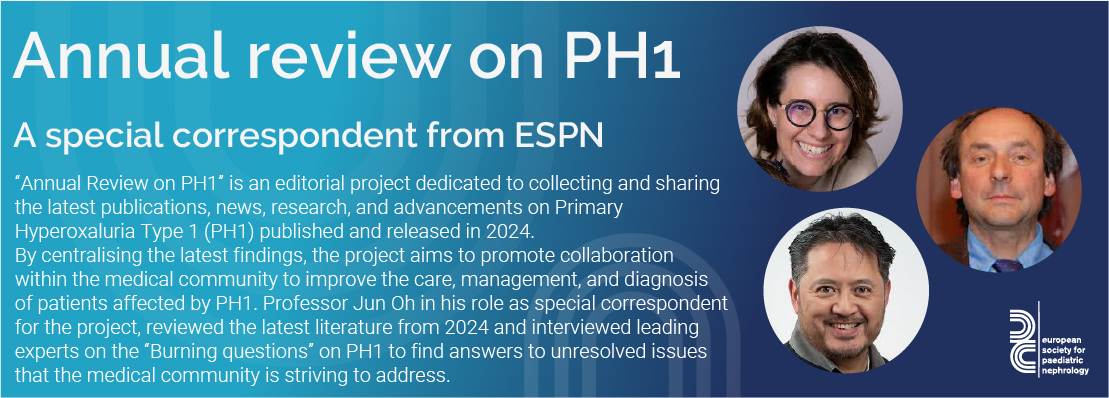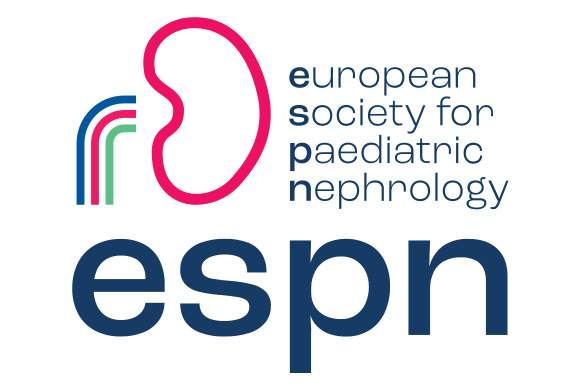Annual Review on PH1

Read the Latest 2024 Updates on RNAi Therapies for PH1:
A Breakthrough in Disease Management
Historically, PH1 treatment has focused on supportive and reactive measures to delay or minimize oxalosis. Management includes hyperhydration, crystallization inhibitors, and pyridoxine, which is only effective in pyridoxine-responsive patients. As kidney function declines, hemodialysis helps reduce oxalate levels but often fails to prevent systemic oxalosis1.
RNA interference (RNAi) therapeutics represent a transformative advancement in PH1 management, offering innovative and emerging treatment options2. As these therapies integrate into clinical practice, several critical considerations emerge to determine the most effective combination and approach for managing patients with PH1. These include understanding potential long-term risks, interpreting real-world efficacy data and optimizing therapeutic strategies. Recent clinical evidence provides valuable insights that can guide these complex decisions.
Lumasiran
Approved in 2020, lumasiran targets glycolate oxidase to reduce hepatic oxalate production. It is indicated for the treatment of PH1 in all age groups3.
The ILLUMINATE clinical trials and phase 2 open label extension study provide robust data supporting its efficacy and safety:
- Long term efficacy: Long-term analyses (ILLUMINATE-A and phase 2 open label extension) revealed sustained UOx reductions of 63% (continuous treatment) and 58% (placebo-to-lumasiran group). eGFR remained stable, kidney stone events dropped from 2.31 to 0.60 per person-year, and nephrocalcinosis improved in 33% of patients. No safety concerns were observed 4,5,6.
- Efficacy in Children: In children under 6 years (ILLUMINATE-B), lumasiran achieved a 76% reduction in urinary oxalate-to-creatinine ratios and a 42% reduction in plasma oxalate. Among children with nephrocalcinosis, 86% showed improvement by 24 months. A late preterm newborn treated with lumasiran at birth demonstrated normal oxalate levels and preserved kidney function after 20 months of follow-up 1,7.
- Efficacy in patients with impaired kidney function: The ILLUMINATE-C trial demonstrated that lumasiran effectively reduced POx levels, helping to preserve kidney function and enabling isolated kidney transplantation without oxalate nephropathy. Among five transplanted patients, all remained hemodialysis-free post-transplant, showing successful metabolic control with continued lumasiran treatment8.
Nedosiran (not approved in Europe)
Nedosiran, which targets lactate dehydrogenase A (LDHA), is under advanced clinical evaluation. It is indicated in children 9 years of age and older and adults with PH1and relatively preserved kidney function, e.g., eGFR ≥ 30 mL/min/1.73 m2.9
- Efficacy and safety (PHYOX3 clinical trial): Clinical trial data indicate that nedosiran sustains a >60% reduction in UOx over 30 months, with stable kidney function. It is essential to assess whether these findings can be replicated in real-world settings, particularly across diverse patient populations 10.
- Pharmacokinetics: Weight-banded dosing regimens tailored to age and renal function enhance safety and efficacy, offering practical guidance for personalized treatment. However, further real-world validation is needed to ensure optimal outcomes 11.
- Managing Different Responses: Clinical findings underscore the importance of continuous monitoring and suggest that flexible dosing strategies may be necessary to achieve optimal patient outcomes 10.
References
- Frishberg, Y. et al. Efficacy and safety of lumasiran for infants and young children with primary hyperoxaluria type 1: 30-month analysis of the phase 3 ILLUMINATE-B trial. Front Pediatr 12, (2024).
- Kang, C. Lumasiran: A Review in Primary Hyperoxaluria Type 1. Drugs 84, 219–226 (2024).
- Oxlumo SmPC. ANNEX I SUMMARY OF PRODUCT CHARACTERISTICS.
- Saland J et al. Long-term Efficacy and Safety of Lumasiran in Patients With Primary Hyperoxaluria Type1:Final Analysis of the ILLUMINATE-A Trial. ASN poster (2024).
- Saland, J. M. et al. Efficacy and Safety of Lumasiran in Patients With Primary Hyperoxaluria Type 1: Results from a Phase III Clinical Trial. Kidney Int Rep 9, 2037–2046 (2024).
- Frishberg Y et al. Long-term Treatment with Lumasiran: Final Results from the Phase 2 Open-Label Extension Study. ERA poster (2024).
- Taroni, F. et al. Case Report: effect of lumasiran treatment in a late preterm baby with antenatal diagnosis of primary hyperoxaluria type 1. Front Pediatr 11, (2023).
- Somers MJ et al. Kidney Function and Isolated Kidney Transplant Outcomes in Primary Hyperoxaluria Type 1 Treated With Long-term Lumasiran. ASN poster (2024).
- Rivfloza SmPC. HIGHLIGHTS OF PRESCRIBING INFORMATION. www.fda.gov/medwatch.
- Groothoff, J. et al. Nedosiran Safety and Efficacy in PH1: Interim Analysis of PHYOX3. Kidney Int Rep 9, 1387–1396 (2024).
- Zhang, S. et al. Nedosiran population pharmacokinetic and pharmacodynamic modelling and simulation to guide clinical development and dose selection in patients with primary hyperoxaluria type 1. Br J Clin Pharmacol (2024)
BURNING QUESTIONS
Watch the Expert Insights and Perspectives
Professor Jun Oh is Professor of Paediatrics and the Head of the Department of Paediatric Nephrology, Ped. Gastroenterology and Ped. Transplantation at the Medical Center of the University Hamburg/Eppendorf
Professor Justine Bacchetta is Professor of Paediatrics, Head of the Paediatric Nephrology Unit, and Vice Chair of the Department of Paediatrics at Femme Mère Enfant Hospital, Lyon Bron, France.
Professor Jaap Groothoff is professor of Paediatrics, with a focus on Paediatric Nephrology, at the University of Amsterdam’s Faculty of Medicine (AMC-UvA).
Is It Time to Skip Liver-Kidney Transplantation?
Read the Latest 2024 Insights on Lumasiran’s Role and PH1 Management Advances
Lumasiran in transplantation
Lumasiran has been shown to effectively reduce plasma oxalate levels, enabling isolated kidney transplantation with stable graft function and improved quality of life in many patients 1,2. Furthermore, Choi et al. 3 documented the first case of complete resolution of PH1-related severe heart failure following isolated kidney transplantation combined with lumasiran and pyridoxine therapy. However, challenges remain in refining transplant strategies and post-transplant care to optimize outcomes for PH1 patients. While RNAi therapies reduce plasma oxalate levels, the release of systemic oxalate from pre-existing deposits persists, necessitating ongoing monitoring 1. This raises important clinical concerns: when is the optimal time to perform kidney-alone transplantation (KALT), and what standards should guide intra- and postoperative management, including the initiation of dialysis to manage oxalate load effectively? The medical community continues to debate whether liver transplantation is still necessary for patients with PH1 considering the advancements and promising results of RNAi therapies. For unresponsive patients or in regions where access to these advanced treatments is limited, liver-kidney transplantation may remain an essential therapeutic option.Transplantation Approaches in PH1
Two studies published in 2024 evaluated CLKT and KALT approaches. Arena et al.4 found no substantial differences in kidney function outcomes between the two strategies after a median follow-up of 3.2 years. Another study of 10 children 5 demonstrated partial improvements in bone health and growth following liver and kidney transplantation, with normalized plasma oxalate levels, resolution of skeletal pain, and moderate catch-up growth observed within 8.1 years. Achieving full bone health recovery remains a gradual process. However, the persistent presence of oxalate in bones warrants innovative measurement techniques for bone oxalate concentration, with methods that could provide better monitoring. In conclusion, while RNAi therapies have redefined the landscape of PH1 treatment, optimizing timing for transplantation, refining intra- and postoperative standards, and addressing persistent oxalate challenges remain critical areas for ongoing research and clinical focus.
References
- Bacchetta, J. et al. Lumasiran, Isolated Kidney Transplantation, and Continued Vigilance. New England Journal of Medicine 390, 1052–1054 (2024).
- Somers MJ et al. Kidney Function and Isolated Kidney Transplant Outcomes in Primary Hyperoxaluria Type 1 Treated With Long-term Lumasiran. ASN poster (2024).
- Choi, M. et al. Recovery From Severe Heart Failure in a Patient With Primary Hyperoxaluria Type 1 After Treatment With Lumasiran, Pyridoxine, and Kidney Transplant. Annals of Internal Medicine Clinical Cases 3, (2024).
- Arena, M. et al. Simultaneous or sequential kidney-liver transplantation in primary hyperoxaluria. Preprint at https://doi.org/10.21203/rs.3.rs-4138380/v1 (2024).
- Büscher, R., Pape, L. & Büscher, A. K. Bone health in children with primary hyperoxaluria type 1 following liver and kidney transplantation. Front Pediatr 12, (2024).
BURNING QUESTIONS
Watch the Expert Insights and Perspectives
Professor Jun Oh is Professor of Paediatrics and the Head of the Department of Paediatric Nephrology, Ped. Gastroenterology and Ped. Transplantation at the Medical Center of the University Hamburg/Eppendorf
Professor Justine Bacchetta is Professor of Paediatrics, Head of the Paediatric Nephrology Unit, and Vice Chair of the Department of Paediatrics at Femme Mère Enfant Hospital, Lyon Bron, France.
Professor Jaap Groothoff is professor of Paediatrics, with a focus on Paediatric Nephrology, at the University of Amsterdam’s Faculty of Medicine (AMC-UvA).
Explore the Latest 2024 Studies on PH1 Management:
Highlighting Genetic, Physiological, and Gender-Specific Factors to Guide Best Practices Across Life Stages
The introduction of RNA interference (RNAi) therapies has revolutionized the management of PH1, emphasizing the critical need for early diagnosis and personalized treatment. Recent studies published in 2024 have highlighted the importance of addressing genetic, gender-specific, and physiological variations across different life stages to guide effective treatment.
New best practice guidelines1 were released to complement existing recommendations, focusing on early detection and long-term management strategies.
A 2024 retrospective study of 83 genetically confirmed PH1 patients under 18 years2 revealed that plasma oxalate (Pox) levels decline rapidly during the first five years of life. However, younger children often exhibit higher urinary oxalate excretion.
Additionally, pregnancy poses unique challenges in PH1 care. A case series3 reported a paradoxical reduction in urinary oxalate levels during pregnancy in PH1 patients, contrasting with the expected physiological increase seen in the general population. Understanding these mechanisms could inform novel therapeutic approaches and enhance the safety of molecular therapies during pregnancy.
PH1 is significantly more common in developing regions, especially in North Africa and the Middle East, compared to Europe, where its prevalence is around 1–3 cases per million4. A nationwide, observational and retrospective study in France found that 32% of PH1 cases that were analyzed originated from the Maghreb, highlighting a disproportionate burden in this region5.
The higher prevalence is linked to genetic and demographic factors, particularly high consanguinity rates, which increase the likelihood of inheriting recessive disorders like PH1. The Ile244Thr mutation in the AGXT gene is notably frequent in North African populations6. In some areas with high consanguinity, PH1 prevalence can reach up to 10%, with many pediatric kidney stone cases showing undifferentiated hyperoxaluria4.
These findings emphasize the urgent need for enhanced screening and early diagnosis programs in developing countries. Genetic testing and emerging RNA interference therapies could improve patient outcomes and reduce the disease burden in these high-risk regions4.
References
- Michael, M. et al. Diagnosis and management of primary hyperoxalurias: best practices. Pediatric Nephrology Preprint at https://doi.org/10.1007/s00467-024-06328-2 (2024).
- Sas, D. J. et al. Natural history of urine and plasma oxalate in children with primary hyperoxaluria type 1. Pediatric Nephrology 39, 141–148 (2024).
- Miao, J. et al. Urinary Oxalate Excretion During Pregnancy in Primary Hyperoxaluria Type 1: A Report of 4 Cases. Kidney Med 6, (2024).
- Huang, Y., Zhu, W., Zhou, J., Huang, Q. & Zeng, G. Navigating the Evolving Landscape of Primary Hyperoxaluria: Traditional Management Defied by the Rise of Novel Molecular Drugs. Biomolecules vol. 14 Preprint at https://doi.org/10.3390/biom14050511 (2024).
- Pszczolinski, R. et al. Primary hyperoxaluria in adults and children: a nationwide cohort highlights a persistent diagnostic delay. Clin Kidney J 17, (2024).
- Aaboudech, T. Y. et al. Unveiling primary Hyperoxaluria type 1: A fortuitous discovery through bone marrow biopsy. Oxf Med Case Reports 2024, (2024).
BURNING QUESTIONS
Watch the Expert Insights and Perspectives
Professor Jun Oh is Professor of Paediatrics and the Head of the Department of Paediatric Nephrology, Ped. Gastroenterology and Ped. Transplantation at the Medical Center of the University Hamburg/Eppendorf
Professor Justine Bacchetta is Professor of Paediatrics, Head of the Paediatric Nephrology Unit, and Vice Chair of the Department of Paediatrics at Femme Mère Enfant Hospital, Lyon Bron, France.
Professor Jaap Groothoff is professor of Paediatrics, with a focus on Paediatric Nephrology, at the University of Amsterdam’s Faculty of Medicine (AMC-UvA).
This program is supported by Alnylam Pharmaceuticals in the form of an unrestricted financial support.
The scientific program has not been influenced in any way by its sponsor.


Rationale
Cystinosis is a rare disease that requires lifelong multidisciplinary care for managing kidney disease and progressive extra-renal complications. Adolescents with cystinosis and their families often face profound psychological distress and significant social challenges, particularly during the critical period of transition from paediatric to adult care.
Due to the rarity of cystinosis, most psychosocial professionals lack expertise in addressing the unique needs of these patients.
This webinar aims to bridge this gap by offering insights into the psychosocial burden and transition challenges during transition and providing expert guidance on psychological support and adherence to therapy.
Learning objectives
After watching this webinar, participants will:
- Familiarize with the psychological and social burden of adolescents with cystinosis.
- Recognize situations requiring psychological support.
- Understand how to address challenges during transition, including treatment adherence.
Faculty: Meet the experts
Moderator

Dieter Haffner
Department of Paediatric Kidney, Liver and Metabolic Diseases, Hannover Medical School, Hannover, Germany
Biography:
Dieter Haffner is a professor of pediatrics and Head of the Department of Paediatric Kidney, Liver, Metabolic and Neurological Diseases and is coordinating the Center for Congenital Kidney Diseases at the Center for Rare Diseases at Hannover Medical School. His main interests are the genetic and mechanistic exploration of rare kidney diseases and mineral and bone disorders in children with chronic kidney disease (CKD-MBD). He is President of the European Society for Paediatric Nephrology (ESPN), IPNA Executive Councilor, Associate Editor of the IPNA Journal Pediatric Nephrology and co-chairman of the Workgroup Immune Glomerulopathies of the European Network for Rare Kidney Diseases (ERKNet). He is former chairman of the IPNA Best Practices and Standards committee, the IPNA Publication Committee, the ESPN CKD-MBD working group, and the ERKNet – Guidelines & Pathways Task Force. He has led, or been heavily involved in, several randomized controlled clinical trials, patient registries, and national, European and international Clinical Practice Guidelines (AWMF, ESPN, ERKNeT, and IPNA). He has also published more than 300 original scientific articles, reviews, editorials and book chapters.
Discussants

Dirk Bethe
Center for Paediatrics and Adolescent Medicine, University Hospital, Heidelberg, Germany
Biography:
Dirk Bethe is a clinical and paediatric psychologist and licensed psychotherapist. He works with the Division of Paediatric Nephrology, Center for Child and Adolescent Medicine, University Hospital Heidelberg, Germany. For many years, he has been supporting and caring for children and adolescents with chronic kidney disease, as well as their families. This also includes families with a child suffering from cystinosis. Dirk Bethe has given many lectures on the psychosocial aspects of chronic kidney disease. He is also a co-author of several articles and textbook chapters. He has been particularly involved in the topics of ‘adherence’ and ‘transition to adult medicine. Dirk Bethe is actively involved in the coordination group of the European Working Group on Psychosocial Aspects of Children with Chronic Kidney Disease (EWOPA).

Lore Willem
Department of Child Nephrology and Organ Transplantation, Leuven University Hospital, Leuven, Belgium
Biography:
Lore Willem (PhD) is a clinical child and adolescent psychologist and licensed Cognitive Behavioral Therapist (CBT). She works in the Department of Paediatric Nephrology and Organ Transplantation of the University Hospitals Leuven. She specialises in paediatric psychology and has written several articles related to this topic. In daily clinical practice, she offers CBT to patients with Chronic Kidney Disease and to patients with a kidney and/or liver transplant. For many years, she has worked with children and adolescents with cystinosis and has offered lectures about the psychological impact of this illness on patients. Lore Willem is actively involved in the coordination group of the European Working Group on Psychosocial Aspects of Children with Chronic Kidney Disease (EWOPA).

Maria Fourikou
3rd Department of Paediatrics, Aristotle University Thessaloniki, Hippokratio Hospital, Thessaloniki, Greece
Biography:
Maria Fourikou is a Pediatrician interested in the Paediatric Nephrology. She currently serves at the Paediatric Nephrology Unit of the 3rd Department of Paediatric, Aristotle University Thessaloniki, Hippokratio General Hospital. As a paediatric nephrology trainee, Maria is involved in the care of patients with rare diseases including X-linked Hypophosphatemia, Primary Hyperoxaluria type 1 and two siblings with Nephropathic Cystinosis. From her experience, clinicians supporting patients with rare chronic diseases cope with the disease and its complications, but also with the bureaucracy in delivering medication, the adherence to therapy and the transition to the adult medical unit. A collaboration of a multidisciplinary team is pivotal for managing rare diseases such as cystinosis.

Stella Stabouliu
1st Department of Paediatrics, Aristotle University Thessaloniki, Hippokratio Hospital, Thessaloniki, Greece
Biography:
Stella Stabouli is a Professor of Paediatrics-Paediatric Nephrology at Aristotle University of Thessaloniki, Greece. She cares for patients with CKD and transplantation as well as patients with rare kidney diseases. She has a profound scientific and research interest in paediatric CKD-MBD, hypertension and cardiovascular disease. She is currently serving as an IPNA councilor. She is also a chairwoman of the European Society Hypertension working group on Blood Pressure in Children and Adolescents and she is participating in the Core Group of the HyperChildNET Cost Action a multidisciplinary European network on BP in children and adolescents. She is a member of the Editorial Board of scientific journals in the field of paediatric nephrology and hypertension and has authored several book chapters and more than 150 scientific articles.
Agenda
Welcome and Introduction
Dieter Haffner
Consensus on Psychosocial Challenges in Patients with Cystinosis
Stella Stabouli
An overview of the key psychosocial challenges faced by adolescents with cystinosis and reccomendations based on clinical consensus.
Patient’s Journey – Part 1*
A short, personal story from a patient, highlighting the real-life challenges and emotional journey of living with cystinosis.
Panel Discussion
Moderation by Dieter Haffner. Discussants: D. Berthe, L. Willem
Patient’s Journey – Part 2*
Continuation of the patient’s story, focusing on adherence to therapy, support from other patients and advocacy groups
Panel Discussion
Moderation by Dieter Haffner. Discussants: M. Fourikou, S. Stabouli, D. Berthe, L. Willem
Conclusions
Dieter Haffner
* The clips shown are part of a longer video that was kindly provided by Chiesi.
Highlights
- Real Patient Perspectives: Explore personal experiences through the “Patient’s Journey” video segments.
- Expert Insights: fruitful discussions with leading professionals addressing psychosocial challenges in cystinosis.
- Collaborative solutions: gaining practical strategies for managing the transition to adult care effectively.
This program is supported by Chiesi Farmaceutici S.p.A. in the form of an unrestricted financial support.
The scientific program has not been influenced in any way by its sponsor.

